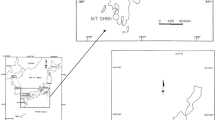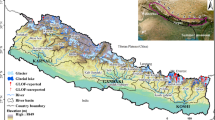Abstract
Based on the analysis of data on temperatures and moisture of soils in the active layer at four different permafrost sites in the source areas of the Yellow River (SAYR) in 2010–2012, the freeze–thaw processes of soils in the active layer were compared and contrasted for understanding the spatiotemporal variations. At the four studied sites, the thickness and mean annual temperature of permafrost are different. The temperatures at the top of permafrost (TTOP), i.e., the maximum depth(s) of seasonal frost and/or thaw penetration, are −1.9 °C at the Chalaping site (CLP), −0.9 °C at the site on the southern bank of the Zhaling Lake (ZLH), −0.4 °C at the Maduo Town site (MDX), and 1.1 °C at the site on the northern bank of the Eling Lake (ELH). Differences in the mean annual ground temperature of permafrost and TTOPs may be responsible for the differentiations in the freeze–thaw processes of soils in the active layer. With rising TTOPs, the ground thawing started earlier: CLP in early June, ZLH in late May, MDX in early May, and ELH in mid-April, while the freezing began later: CLP in early October, ZLH in early to mid-October, MDX in mid-October, and ELH in the mid- to late October. With increasing TTOPs, the freeze-up periods for permafrost sites were shortened: 202 days at CLP, 130 days at ZLH, 100 days at MDX, and the period of complete thaw was 89 days at ELH. At the CLP and ZLH sites, the two-directional ground freezing (downwards from ground surfaces and upwards from the permafrost table) and thawing finished in the same year, but the ground freezing at the MDX continued to the end of the next January, with very slow freezing rates in the end. At the ELH site, ground freezing kept on until early May when thawing began on the surface, and upward and downward thawing became increasingly stable in late June to early July. At each site, with rising TTOPs, the downward freezing accelerated in comparison with the upward freezing, and with an increasing proportion of downward frozen depth, and with the larger ratios of freezing to thawing duration. In summary, the patterns of thawing and freezing processes in the active layer in the SAYR differ from those in other parts of the Qinghai–Tibet Plateau to a noticeable extent.







Similar content being viewed by others
References
Zhou YW, Guo DX, Qiu GQ et al (2000) Geocryology in China. Science Press, Beijing (in Chinese)
van Everdingen RO (ed) (1998, revised 2005) Multi-language glossary of permafrost and related ground-ice terms. The Arctic Institute of North American, the University of Calgary, Calgary
Hollesen J, Elberling B, Jansson P (2011) Future active layer dynamics and carbon dioxide production from thawing permafrost layers in Northeast Greenland. Glob Chang Biol 17:911–926
Anisimov OA, Shiklomanov NI, Nelson FE (1997) Global warming and active-layer thickness: results from transient general circulation models. Glob Planet Change 15:61–77
Vincent WF, Whyte LG, Connie L et al (2009) Arctic microbial ecosystems and impacts of extreme warming during the International Polar Year. Polar Sci 3:171–180
Wu QB, Niu FJ (2013) Permafrost changes and engineering stability in Qinghai–Xizang Plateau. Chin Sci Bull 58:115–130
Wu QB, Shen YP, Shi B (2003) Relationship between frozen soil together with its water-heat process and ecological environment in the Tibetan Plateau. J Glaciol Geocryol 25:250–255 (in Chinese)
Guglielmin M, Evans CJE, Cannone N (2008) Active layer thermal regime under different vegetation conditions in permafrost areas. A case study at Signy Island (Maritime Antarctica). Geoderma 144:73–85
Li S, Gao SY, Yang P et al (2005) Some problems of freeze-thaw desertification on the Tibetan Plateau: a case study on the desertification regions of the western and northern plateau. J Glaciol Geocryol 27:476–485 (in Chinese)
Guglielmin M, Worland MR, Cannone N (2012) Spatial and temporal variability of ground surface temperature and active layer thickness at the margin of maritime Antarctica, Signy Island. Geomorphol 155–156:20–33
Hu HC, Wang GX, Wang YB et al (2009) Response of soil heat-water processes to vegetation cover on the typical permafrost and seasonally frozen soil in the headwaters of the Yangtze and Yellow Rivers. Chin Sci Bull 54:1225–1233
Nowinski NS, Taneva L, Trumbore SE et al (2010) Decomposition of old organic matter as a result of deeper active layers in a snow depth manipulation experiment. Oecologia 163:785–792
Minke M, Donner N, Karpov N et al (2009) Patterns in vegetation composition, surface height and thaw depth in polygon mires in the Yakutian Arctic (NE Siberia): a microtopographical characterisation of the active layer. Permafrost Periglacial Process 20:357–368
Wright N, Hayashi M, William LQ (2009) Spatial and temporal variations in active layer thawing and their implication on runoff generation in peat-covered permafrost terrain. Water Resour Res 45:W05414. doi:10.1029/2008WR006880
Ling F, Zhang TJ (2003) Impact of the timing and duration of seasonal snow cover on the active layer and permafrost in the Alaskan Arctic. Permafrost Periglacial Process 14:141–150
Wang GX, Liu LA, Liu GS et al (2010) Impacts of grassland vegetation cover on the active-layer thermal regime, northeast Qinghai–Tibet Plateau, China. Permafrost Periglacial Process 21:335–344
Romanovsky VE, Osterkamp T (1997) Thawing of the active layer on the coastal plain of the Alaskan Arctic. Permafrost Periglacial Process 8:1–22
Zhao L, Cheng GD, Li SX et al (2000) Thawing and freezing processes of active layer in Wudaoliang region of Tibetan Plateau. Chin Sci Bull 45:2181–2187
Osterkamp T, Romanovsky VE (1997) Freezing of the active layer on the coastal plain of the Alaskan Arctic. Permafrost Periglacial Process 8:23–44
Wang JC, Guo DX, Huang YZ et al (1989) A study on seasonally thawed layer in the basin of Huola River in northern Da Hinggan Ling. J Glaciol Geocryol 11:203–214 (in Chinese)
Wu QB, Zhang TJ (2010) Changes in active layer thickness over the Qinghai–Tibetan Plateau from 1995 to 2007. J Geophys Res 115:D09107. doi:10.1029/2009JD012974
Romanovsky VE, Osterkamp TE (1995) Interannual variations of the thermal regime of the active layer and near-surface permafrost in northern Alaska. Permafrost Periglacial Process 6:313–335
Shiklomanov NI, Streletskiy DA, Nelson FE, et al (2010) Decadal variations of active-layer thickness in moisture-controlled landscapes, Barrow, Alaska. J Geophys Res 115:G00I04. doi:10.1029/2009JG001248
Li R, Zhao L, Ding YJ et al (2012) Temporal and spatial variations of the active layer along the Qinghai–Tibet Highway in a permafrost region. Chin Sci Bull 57:2864–2871
Jin HJ, He RX, Cheng GD et al (2009) Changes in frozen ground in the Source Area of the Yellow River on the Qinghai–Tibet Plateau, China, and their eco-environmental impacts. Environ Res Lett 4:1–11
Luo DL, Jin HJ, Lin L et al (2012) Progress on permafrost temperature and thickness in the source area of the Huanghe River. Sci Geogr Sin 32:898–904 (in Chinese)
Liang SH, Xu DW, Wan L et al (2008) Periodic regularity of the base flow in the headwater region of the Yellow River and affecting factors. Earth Sci Front 15:280–289 (in Chinese)
Wang YB, Wang GX, Zhang CM et al (2007) Response of soil physicochemical properties to the changes of the vegetation ecosystem on the Tibetan Plateau. J Glaciol Geocryol 29:921–927 (in Chinese)
Mutter Z, Phillips EM (2012) Active layer characteristics at ten borehole sites in alpine permafrost terrain, Switzerland. Permafrost Periglacial Process 23:138–151
Müller SW (ed) (1947) Permafrost or permanently frozen ground and related engineering problems. J W Edwards, Ann Arbor
Cheng GD (2004) Influence of local factors on permafrost occurrence and their implications for the Qinghai–Tibet Railway design. Sci China Ser D-Earth Sci 47:704–709
Kimble J (ed) (2004) Cryosols: permafrost-affected soils. Springer, Heidelberg
Xia K, Luo Y, Li WP (2011) Simulation of freezing and melting of soil on the northeast Tibetan Plateau. Chin Sci Bull 56:2145–2155
Outcalt SI, Nelson FE, Hinkel KM (1990) The zero-curtain effect: heat and mass transfer across an isothermal region in freezing soil. Water Resour Res 26:1509–1516
Acknowledgments
This work was supported by the National Natural Science Foundation of China (41301068), Global Change Research Program of China (2010CB951402), Excellent Youth Scholars Fund of Cold and Arid Regions Environmental and Engineering Research Institute, Chinese Academy of Sciences (51Y351051), and Research Fund of State Key Laboratory of Frozen Soils Engineering (SKLFSE-ZQ-18). The authors are much appreciated of the anonymous reviewers for their generous help in revising and editing the manuscript, and Professors Geoffrey Gay and Stuart A. Harris for English editing.
Author information
Authors and Affiliations
Corresponding author
About this article
Cite this article
Luo, D., Jin, H., Lü, L. et al. Spatiotemporal characteristics of freezing and thawing of the active layer in the source areas of the Yellow River (SAYR). Chin. Sci. Bull. 59, 3034–3045 (2014). https://doi.org/10.1007/s11434-014-0189-6
Received:
Accepted:
Published:
Issue Date:
DOI: https://doi.org/10.1007/s11434-014-0189-6




